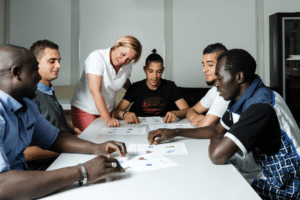Would you like to use gamestorming in your training session? Great idea! Before jumping in, however, discover and remember these 10 essential points to ensure good game conduct. Once you have mastered them, you will be well equipped to design innovative, original and creative sessions!
1. Focus on opening and closing
The opening and closing are essential for a successful gamestorming session. The opening, for example, should stimulate reflection and imagination in the team. Your role as a trainer is to create an environment conducive to open-mindedness, the breaking down of mental barriers limiting creativity and the exploration of all possibilities.
Likewise, the closing should make it possible to progress from thought to action. The participants are therefore invited to take decisions. You should direct the conversation towards the selection of solutions and the application of ideas.
Two pitfalls to avoid when preparing the session:
- Confusing the opening and the closing. Separate time for creativity and time for critical review. The imagination works well when it is free of constraints and judgement. The critical spirit, on the other hand, is sharper and better able to expand during a reflective phase.
- Close each stage. As each phase is well-defined, the group’s energy can only be maintained when the participants have the impression of progressing from one phase to another. Without any closing, discussions drag on, ideas get mixed up and risk never being implemented. Consider highlighting the end of each stage, therefore, in order to guide the group.
2. Fire up the imagination
Nothing is as effective for stimulating your trainees’ imagination than asking questions. To do this, use wording to test the water, raise ideas, examine the causes of a problem, enrich the discussion or change the position of your team.
Another technique is to leave blanks. Say things like ‘I want…’, I would like…’ and ‘I expect…’ and let your trainees complete the phrase. This strategy is particularly effective in simulated situations.
For example, you may be helping a team to think about customer relations. During an exercise, take the place of the buyer for a few moments, opposite a trainee in the role of the seller; the other participants contribute to the exchange with their own proposals and experiences. Rather than asking questions about what the customer needs, say things like ‘As the customer, I want…’, ‘As the customer, I need… ‘ and ‘As the customer, I don’t like…’ and let the trainees fill in the blanks. In this way, you will get a variety of spontaneous responses to help you highlight certain situations and identify potential problems.
3. Use artefacts
Remember, artefacts are supports with which to model ideas (Post-its, accessories, etc.). During a lively exchange, what is only spoken risks being forgotten. Propose or use artefacts on which all the ideas are written down. Hence, once the opening phase is over, you can, as a team, organize and sort the ideas before moving on to the next phase.
4. Atom generation
How can we transform artefacts from a simple medium (single Post-it) into an ‘atom’ or ‘node’ (part of the whole)? Thanks to a simple technique: distribute a pile of Post-its to each participant. Ask your question and ask the trainees to respond individually and in silence. No lists: each idea must be noted on a separate Post-it. The exercise ends when everyone has presented their idea by sticking their atom on the board.
This way, you obtain a variety of responses not influenced by the group and that can be arranged into tables, circles, hierarchies, etc.
5. Build a meaningful space
Once the atoms are filled in, they need to be arranged in a certain order in facilitate understanding and enable them to be sorted. When you create a meaningful space (tables, boxes, columns, etc.) you guide the process and turn a disorganised set of ideas into a structured whole.
Take the previous exercise, for example: once all the Post-its have been stuck on the board, divide the board into difference parts and ask the team to organize the ideas into meaningful groups. This will reveal certain paths and eliminate redundancies.
These three tools (artefacts, atoms and meaningful spaces) are used as follows: the participants note their ideas on the artefacts. Once there are a certain number of artefacts, they become atoms. These atoms are then arranged into a meaningful space.
6. Sketching
Next phase: transform these ideas into diagrams to bring your ideas to life. Replacing text by an image shapes the concepts contained within. Artists, web designers and architects all make sketches before starting to paint, design or draw up the final idea. A sketch enables you to move the feasibility process forward with minimal effort.
7. Provide space for reframing
Throughout the process, you will notice that the human mind is constantly following a pattern: a logical progression, a chronological order, a division into themes, etc. Feel free to reverse the situation to look at your ideas afresh. This is particularly useful if the group feels it is at an impasse: the simple fact of mixing up the atoms again can shed new light on the problem and throw up unexpected solutions.
8. Use improvisation
Feel free to use improvisation through role plays, simulated situations and prototyping. This technique can allow new ideas to emerge.
9. Selection
If you have too many ideas to explore them all, review your priorities. You can eliminate ideas by voting on them or by prioritizing the atoms. Participants can vote by a show of hands, by ranking them (each participant votes for their top 3 ideas) or based on which idea the participants would pay the most money for.
10. Try something new
Discovery comes through exploring your own approach to the game. Try new scenarios, use your environment and try to vary the forms of your games. If you always follow the same process, you will one day find yourself stuck in a model that no longer works or is no longer suitable for your session.
Gamestorming includes a very wide range of game models. Your sessions will suffer, however, if you fail to assimilate these 10 essential points. By testing them out, adapting them and challenging them you will have everything you need to run successful gamestorming sessions.












